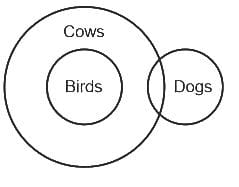Mechanical Engineering Exam > Mechanical Engineering Questions > Two statements are given followed by two conc...
Start Learning for Free
Two statements are given followed by two conclusions numbered I and II. Assuming the statements to be true, even if they seem to be at variance with commonly known facts, decide which of the conclusions logically follow(s) from the statements.
Statements:
All birds are cows.
Some cows are dogs.
Conclusions:
I. Some dogs are birds.
II. Some cows are birds.
- a)Neither conclusion I nor II follows
- b)Only conclusion II follows
- c)Only conclusion I follows
- d)Both conclusions I and II follow
Correct answer is option 'B'. Can you explain this answer?
Verified Answer
Two statements are given followed by two conclusions numbered I and II...
Statements:
All birds are cows.
Some cows are dogs.
The Venn diagram as per the given statements:

Conclusions:
I. Some dogs are birds.
→ Not follow (There is no direct relation between dogs and birds so it can be possible but not definitely true)
II. Some cows are birds.
→ Follow (Because all birds are cows, so some cows are birds is definitely true)
Hence, the correct answer is "Only conclusion II follows".
Most Upvoted Answer
Two statements are given followed by two conclusions numbered I and II...
Understanding the Statements
The statements provided are:
- All birds are cows.
- Some cows are dogs.
These statements create a specific relationship between the groups of birds, cows, and dogs.
Analyzing the Conclusions
Now, let’s evaluate the conclusions based on the statements:
Conclusion I: Some dogs are birds.
- Since "All birds are cows," every bird must be included in the group of cows.
- The statement "Some cows are dogs" means there is an overlap between cows and dogs, but it does not imply that any of those cows that are dogs are also birds.
- Therefore, we cannot definitively conclude that some dogs are birds.
Conclusion II: Some cows are birds.
- Since "All birds are cows," it follows that all birds belong to the group of cows.
- This implies that there must be at least some cows that are birds, fulfilling the requirement of the statement.
- Hence, this conclusion logically follows from the statements.
Final Assessment
Based on the evaluation:
- Conclusion I does not logically follow.
- Conclusion II does logically follow.
Thus, the correct answer is option 'B': Only conclusion II follows.
The statements provided are:
- All birds are cows.
- Some cows are dogs.
These statements create a specific relationship between the groups of birds, cows, and dogs.
Analyzing the Conclusions
Now, let’s evaluate the conclusions based on the statements:
Conclusion I: Some dogs are birds.
- Since "All birds are cows," every bird must be included in the group of cows.
- The statement "Some cows are dogs" means there is an overlap between cows and dogs, but it does not imply that any of those cows that are dogs are also birds.
- Therefore, we cannot definitively conclude that some dogs are birds.
Conclusion II: Some cows are birds.
- Since "All birds are cows," it follows that all birds belong to the group of cows.
- This implies that there must be at least some cows that are birds, fulfilling the requirement of the statement.
- Hence, this conclusion logically follows from the statements.
Final Assessment
Based on the evaluation:
- Conclusion I does not logically follow.
- Conclusion II does logically follow.
Thus, the correct answer is option 'B': Only conclusion II follows.

|
Explore Courses for Mechanical Engineering exam
|

|
Question Description
Two statements are given followed by two conclusions numbered I and II. Assuming the statements to be true, even if they seem to be at variance with commonly known facts, decide which of the conclusions logically follow(s) from the statements.Statements:All birds are cows.Some cows are dogs.Conclusions:I. Some dogs are birds.II. Some cows are birds.a)Neither conclusion I nor II followsb)Only conclusion II followsc)Only conclusion I followsd)Both conclusions I and II followCorrect answer is option 'B'. Can you explain this answer? for Mechanical Engineering 2025 is part of Mechanical Engineering preparation. The Question and answers have been prepared according to the Mechanical Engineering exam syllabus. Information about Two statements are given followed by two conclusions numbered I and II. Assuming the statements to be true, even if they seem to be at variance with commonly known facts, decide which of the conclusions logically follow(s) from the statements.Statements:All birds are cows.Some cows are dogs.Conclusions:I. Some dogs are birds.II. Some cows are birds.a)Neither conclusion I nor II followsb)Only conclusion II followsc)Only conclusion I followsd)Both conclusions I and II followCorrect answer is option 'B'. Can you explain this answer? covers all topics & solutions for Mechanical Engineering 2025 Exam. Find important definitions, questions, meanings, examples, exercises and tests below for Two statements are given followed by two conclusions numbered I and II. Assuming the statements to be true, even if they seem to be at variance with commonly known facts, decide which of the conclusions logically follow(s) from the statements.Statements:All birds are cows.Some cows are dogs.Conclusions:I. Some dogs are birds.II. Some cows are birds.a)Neither conclusion I nor II followsb)Only conclusion II followsc)Only conclusion I followsd)Both conclusions I and II followCorrect answer is option 'B'. Can you explain this answer?.
Two statements are given followed by two conclusions numbered I and II. Assuming the statements to be true, even if they seem to be at variance with commonly known facts, decide which of the conclusions logically follow(s) from the statements.Statements:All birds are cows.Some cows are dogs.Conclusions:I. Some dogs are birds.II. Some cows are birds.a)Neither conclusion I nor II followsb)Only conclusion II followsc)Only conclusion I followsd)Both conclusions I and II followCorrect answer is option 'B'. Can you explain this answer? for Mechanical Engineering 2025 is part of Mechanical Engineering preparation. The Question and answers have been prepared according to the Mechanical Engineering exam syllabus. Information about Two statements are given followed by two conclusions numbered I and II. Assuming the statements to be true, even if they seem to be at variance with commonly known facts, decide which of the conclusions logically follow(s) from the statements.Statements:All birds are cows.Some cows are dogs.Conclusions:I. Some dogs are birds.II. Some cows are birds.a)Neither conclusion I nor II followsb)Only conclusion II followsc)Only conclusion I followsd)Both conclusions I and II followCorrect answer is option 'B'. Can you explain this answer? covers all topics & solutions for Mechanical Engineering 2025 Exam. Find important definitions, questions, meanings, examples, exercises and tests below for Two statements are given followed by two conclusions numbered I and II. Assuming the statements to be true, even if they seem to be at variance with commonly known facts, decide which of the conclusions logically follow(s) from the statements.Statements:All birds are cows.Some cows are dogs.Conclusions:I. Some dogs are birds.II. Some cows are birds.a)Neither conclusion I nor II followsb)Only conclusion II followsc)Only conclusion I followsd)Both conclusions I and II followCorrect answer is option 'B'. Can you explain this answer?.
Solutions for Two statements are given followed by two conclusions numbered I and II. Assuming the statements to be true, even if they seem to be at variance with commonly known facts, decide which of the conclusions logically follow(s) from the statements.Statements:All birds are cows.Some cows are dogs.Conclusions:I. Some dogs are birds.II. Some cows are birds.a)Neither conclusion I nor II followsb)Only conclusion II followsc)Only conclusion I followsd)Both conclusions I and II followCorrect answer is option 'B'. Can you explain this answer? in English & in Hindi are available as part of our courses for Mechanical Engineering.
Download more important topics, notes, lectures and mock test series for Mechanical Engineering Exam by signing up for free.
Here you can find the meaning of Two statements are given followed by two conclusions numbered I and II. Assuming the statements to be true, even if they seem to be at variance with commonly known facts, decide which of the conclusions logically follow(s) from the statements.Statements:All birds are cows.Some cows are dogs.Conclusions:I. Some dogs are birds.II. Some cows are birds.a)Neither conclusion I nor II followsb)Only conclusion II followsc)Only conclusion I followsd)Both conclusions I and II followCorrect answer is option 'B'. Can you explain this answer? defined & explained in the simplest way possible. Besides giving the explanation of
Two statements are given followed by two conclusions numbered I and II. Assuming the statements to be true, even if they seem to be at variance with commonly known facts, decide which of the conclusions logically follow(s) from the statements.Statements:All birds are cows.Some cows are dogs.Conclusions:I. Some dogs are birds.II. Some cows are birds.a)Neither conclusion I nor II followsb)Only conclusion II followsc)Only conclusion I followsd)Both conclusions I and II followCorrect answer is option 'B'. Can you explain this answer?, a detailed solution for Two statements are given followed by two conclusions numbered I and II. Assuming the statements to be true, even if they seem to be at variance with commonly known facts, decide which of the conclusions logically follow(s) from the statements.Statements:All birds are cows.Some cows are dogs.Conclusions:I. Some dogs are birds.II. Some cows are birds.a)Neither conclusion I nor II followsb)Only conclusion II followsc)Only conclusion I followsd)Both conclusions I and II followCorrect answer is option 'B'. Can you explain this answer? has been provided alongside types of Two statements are given followed by two conclusions numbered I and II. Assuming the statements to be true, even if they seem to be at variance with commonly known facts, decide which of the conclusions logically follow(s) from the statements.Statements:All birds are cows.Some cows are dogs.Conclusions:I. Some dogs are birds.II. Some cows are birds.a)Neither conclusion I nor II followsb)Only conclusion II followsc)Only conclusion I followsd)Both conclusions I and II followCorrect answer is option 'B'. Can you explain this answer? theory, EduRev gives you an
ample number of questions to practice Two statements are given followed by two conclusions numbered I and II. Assuming the statements to be true, even if they seem to be at variance with commonly known facts, decide which of the conclusions logically follow(s) from the statements.Statements:All birds are cows.Some cows are dogs.Conclusions:I. Some dogs are birds.II. Some cows are birds.a)Neither conclusion I nor II followsb)Only conclusion II followsc)Only conclusion I followsd)Both conclusions I and II followCorrect answer is option 'B'. Can you explain this answer? tests, examples and also practice Mechanical Engineering tests.

|
Explore Courses for Mechanical Engineering exam
|

|
Signup to solve all Doubts
Signup to see your scores go up within 7 days! Learn & Practice with 1000+ FREE Notes, Videos & Tests.
























